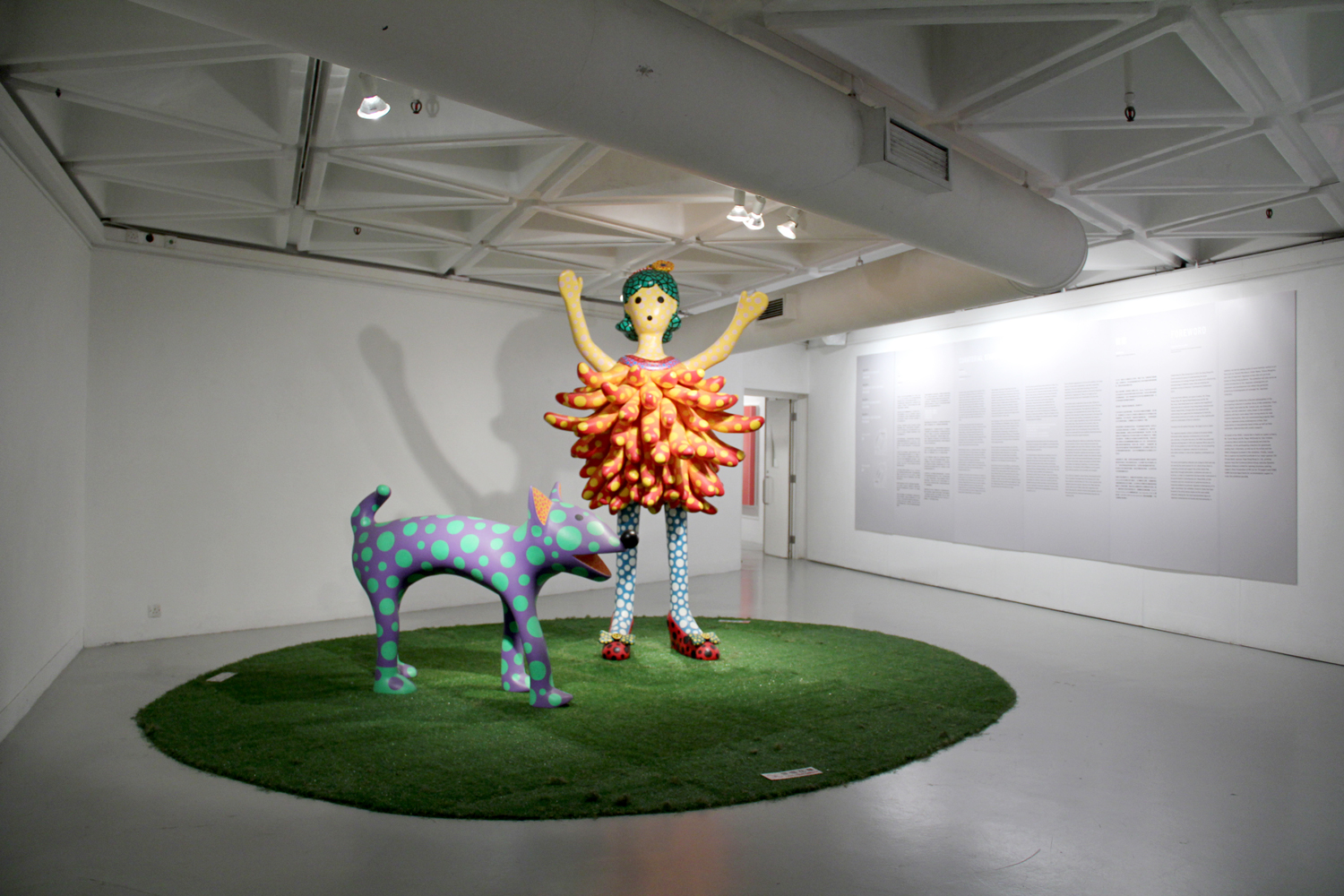Shows
4th Annual Collectors’ Contemporary Collaboration: Intimate Curiosity


When visitors walk into the Pao Galleries space of the Hong Kong Arts Centre (HKAC) for its current exhibition, they are immediately greeted by a large, colorfully polka-dotted statue of a girl, with her arms open in a welcoming gesture, and her dog on a circular patch of artificial grass. The sculptures—Hi, Konnichiwa (Hello)! Yayoi-chan and Pochi (2004), respectively—are the creation of Japanese art doyenne Yayoi Kusama. Their eerily expressionless, black-painted eyes, which are in sheer contrast to the bubbly palette of the overall installation, add a sense of menace to their looming stature. Kusama’s work is showing as part of “Intimate Curiosity,” the fourth edition of the annual Collectors’ Contemporary Collaboration (CCC). Established in 2013 to “examine the role and contributions of private collectors to the development of Asian art scenes,” this year’s CCC was guest-curated by Fumio Nanjo, director of the Mori Art Museum, and independent curator Roger McDonald, both based in Tokyo.
“Intimate Curiosity” focuses on artworks from prominent, Japanese private collections—including that of Keita Arisawa, Daisuke Miyatsu, Yoshiko Mori, Takeo Obayashi, Atom Suematsu, Ryutaro Takahashi and Seiichi Yoshino—which are not only diverse in medium, but also in genres and subject matter. Though the majority of art on display are by Japanese artists, works by their peers from other countries are also included, effectively presenting the breadth of the collectors’ contribution to their local art community, as well as to the international art world at large.

Another work in the exhibition by Kusama is Infinity Mirrored Room—Love Forever (No.3) (1964–86), a curious, cubic installation covered entirely in silver phallic protrusions, which sits atop a mirror-paneled pedestal. Upon closer examination of one side of the bulbous box, viewers will find a small window that allows a look inside—where mirror-like interior walls surround a heard of small, red-and-white striped protrusions that fill the bottom surface. As the work’s title implies, the mirror-on-mirror composition creates an enigmatic illusion wherein the interior space, and hence the phallic growths, appear to multiple and recede infinitely into the abyss.
Fantastical explorations of sexual motifs are further seen in a video by Thai artist Boonsri Tangtrongsin, entitled Superbarbara Saving the World (2012–13). The black-and-white animation is a compilation of 12 short episodes that each features a different misadventure involving an animate blow-up doll named Superbarbara, who tries to “save the world” through earnest yet comically perverse ways, and a gang of mischievous crows who foil her every attempt. In a particularly dark and delightful episode, Superbarbara is shown comforting a crying baby—the twist being that the latter is actually a small, middle-aged man in a suit, lying inside a carriage. The scene starts out with Superbarabara deflated on the ground, connected to an air pump, and the man-baby crying in his stroller nearby. A crow jumps onto the pump to inflate Superbarabara, making the man-baby giggle grotesquely with joy. Immediately the crow jumps off the pump, and Superbarabara falls down, throwing the man-baby into a tantrum. Then the crow jumps back onto the pump and the man-baby is happy to see the re-inflated Superbarabara, and the same sequence is repeated again and again in a hypnotic loop until the scene fades and the next episode begins. Superbarabara’s Sisyphean attempts seem to be a sardonic commentary on the cycle of corruption and hypocrisy that often hinder people and nations, but also at times humanitarian charities and organizations, from “saving the world.”

A quiet standout of the exhibition is postwar experimental photographer Eikoh Hosoe’s “Ordeal by Roses” (1961/1970), a series of striking, erotic portraits of his friend and Japanese avant-garde novelist Yukio Mishima. Inside a small nook in a nondescript corner of the gallery floor, four of Hosoe’s black-and-white photographs hang discreetly on a wall. Despite their modest display arrangement, the images have a commanding presence in their raw sexuality. All photographed at Mishima’s then residence in Japan, one work, Ordeal by Roses #1 (1961), shows the muscular author standing solemnly on the steps of what appear to be a European-style foyer, wearing just his underwear and a single rose tied to his neck. In the background, another naked man is posing in profile with chains hanging down his body. The grainy, high-contrast aesthetic of the photograph further emphasizes the subject’s menacing sensuality, which is portrayed in an elegantly conceptual manner throughout the series.
“Intimate Curiosity” is an apt title for the exhibition. Though there are multiple levels and rooms within the gallery space, they are situated in somewhat awkward configurations, allowing for visitors to hide away in unexpected corners and rooms for an intimate viewing experience of the works. Ranging from painting and sculpture to photography and video, from the aesthetically pleasing to the conceptually challenging, the diverse collection offers visitors with a ruminative experience.

“4th Annual Collectors’ Contemporary Collaboration: Intimate Curiosity” is on view at Hong Kong Arts Centre until April 10, 2016.
Hanae Ko is reviews and web editor at ArtAsiaPacific.







